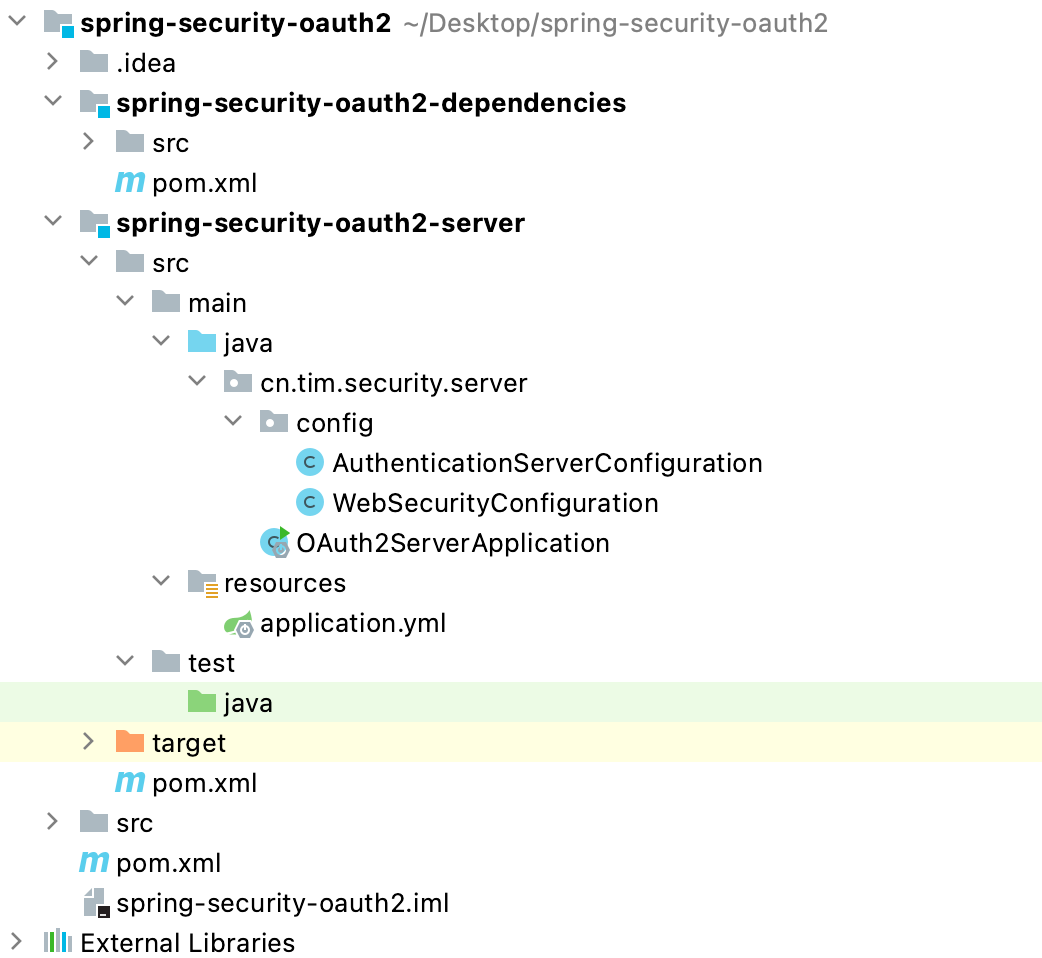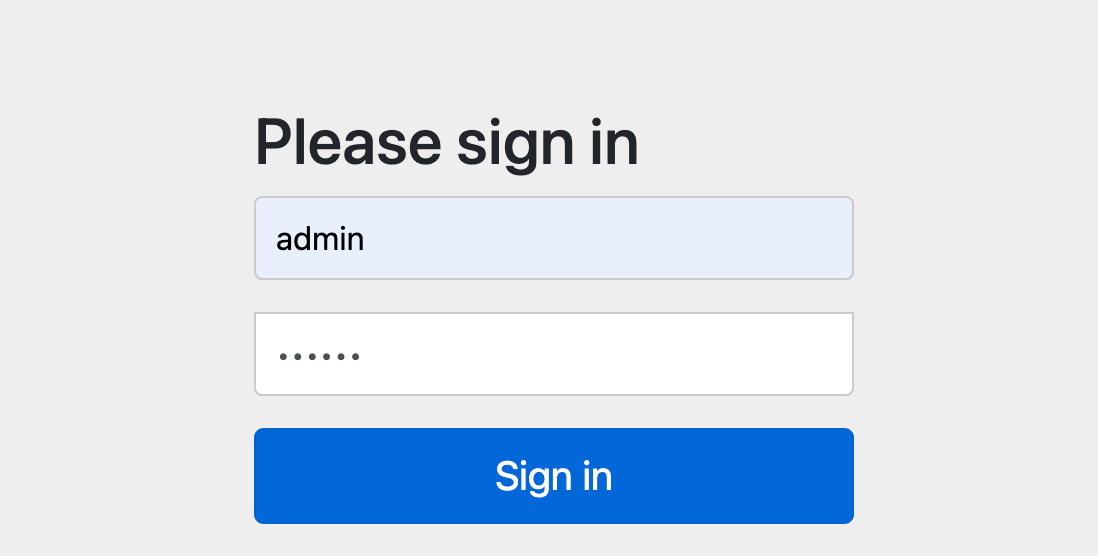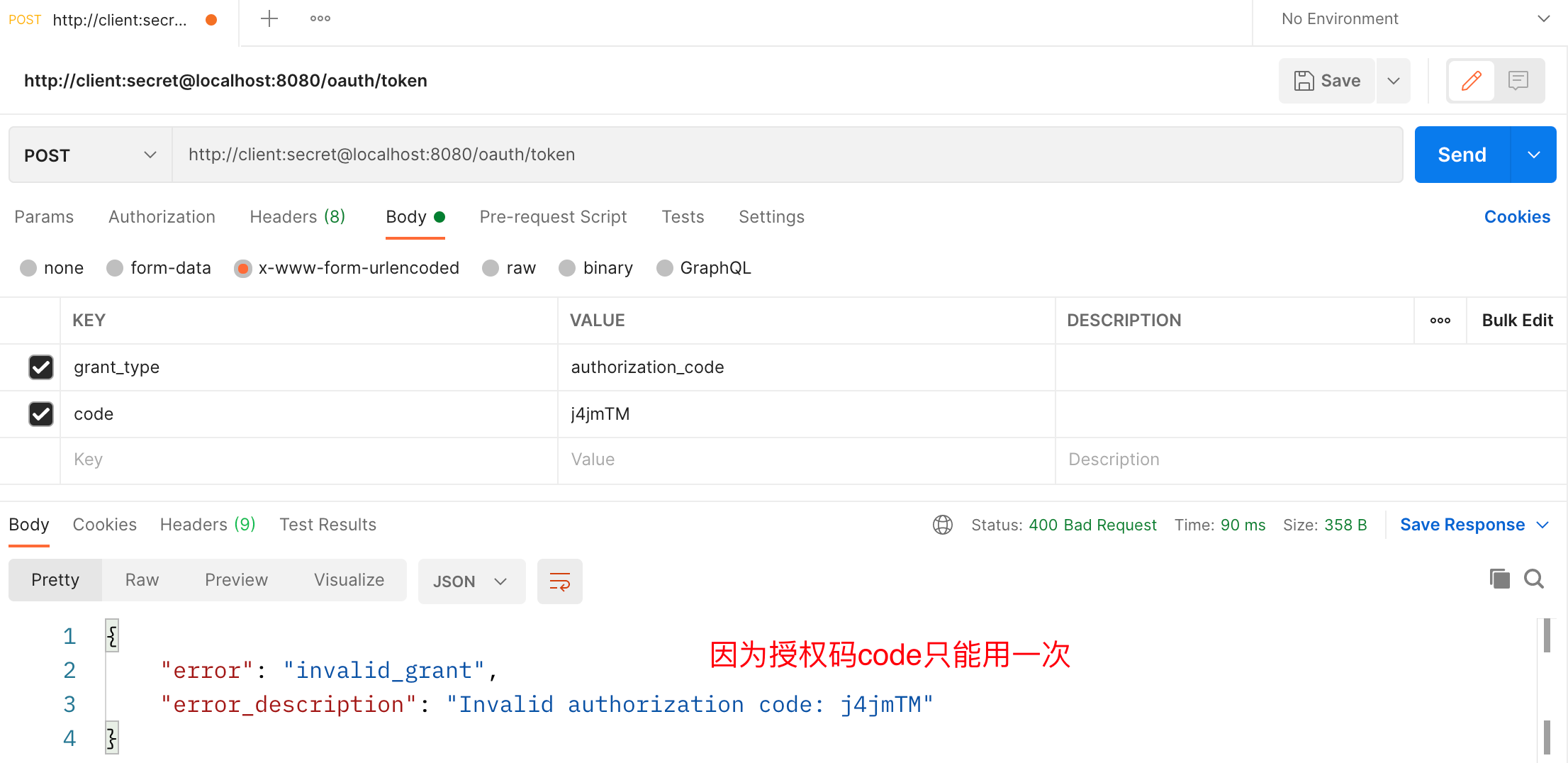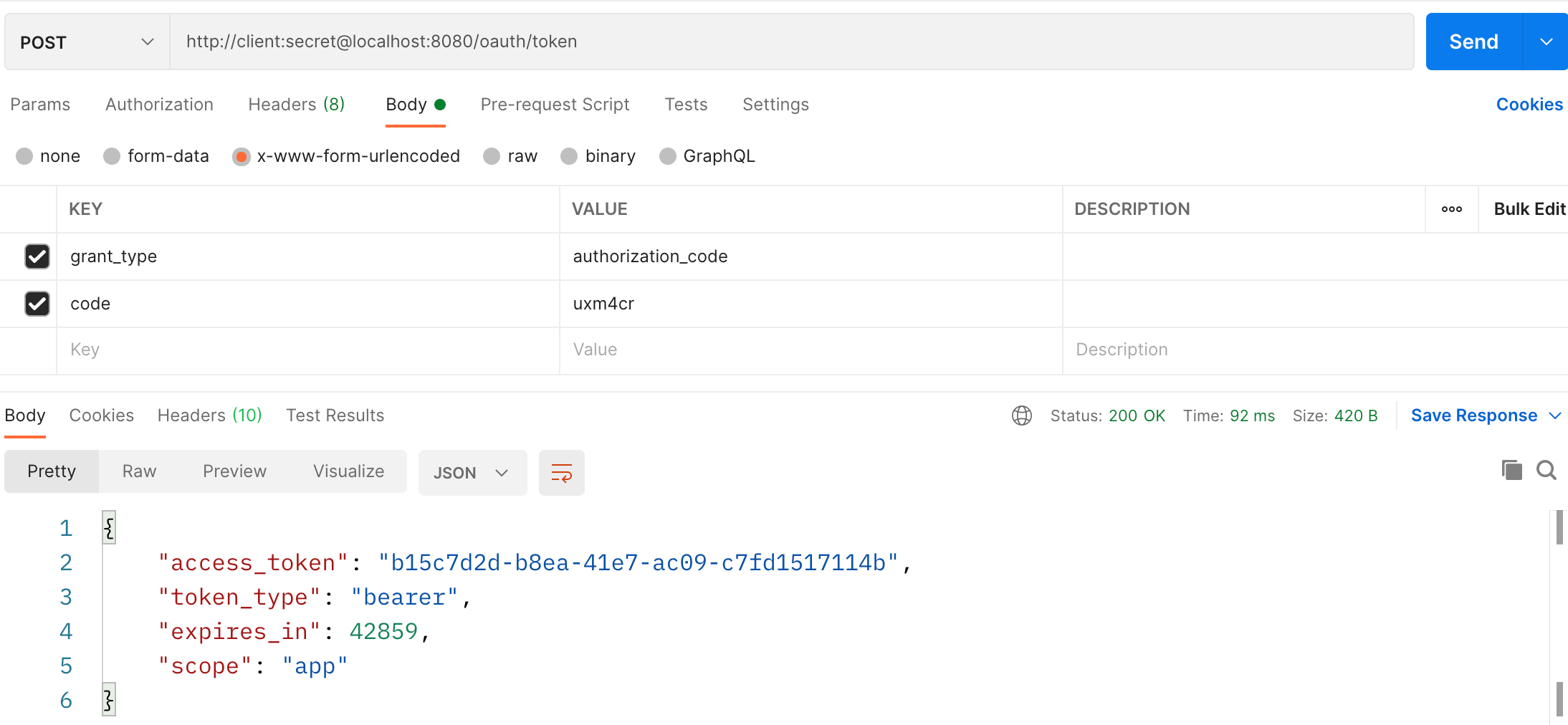Spring Security oAuth2(二)
在 《Spring Security oAuth2(一)》 中主要是oAuth的一些基本概念与四种认证方式,现在就正式开始完成几个主要示例,快速上手Spring提供的Spring Security oAuth2。网上很多示例教程都是使用 JWT(JSON Web Tokens)来管理Token,于是很多人认为oAuth2就应该用JWT来管理Token,其实这是非常错误的想法,后面我会专门就使用 JWT 这个问题进行讨论,看看 JWT 的最佳使用场景。
创建oAuth2 示例工程
新建名为spring-security-oauth2的Maven工程,pom.xml(spring-security-oauth2)如下:
<?xml version="1.0" encoding="UTF-8"?>
<project xmlns="http://maven.apache.org/POM/4.0.0"
xmlns:xsi="http://www.w3.org/2001/XMLSchema-instance"
xsi:schemaLocation="http://maven.apache.org/POM/4.0.0 http://maven.apache.org/xsd/maven-4.0.0.xsd">
<modelVersion>4.0.0</modelVersion>
<parent>
<groupId>org.springframework.boot</groupId>
<artifactId>spring-boot-starter-parent</artifactId>
<version>2.3.10.RELEASE</version>
<relativePath/> <!-- lookup parent from repository -->
</parent>
<groupId>cn.tim</groupId>
<artifactId>spring-security-oauth2</artifactId>
<packaging>pom</packaging>
<version>1.0-SNAPSHOT</version>
<modules>
<module>spring-security-oauth2-server</module>
<module>spring-security-oauth2-dependencies</module>
</modules>
<properties>
<maven.compiler.source>8</maven.compiler.source>
<maven.compiler.target>8</maven.compiler.target>
</properties>
<dependencyManagement>
<dependencies>
<dependency>
<groupId>cn.tim</groupId>
<artifactId>spring-security-oauth2-dependencies</artifactId>
<version>1.0.0-SNAPSHOT</version>
<type>pom</type>
<scope>import</scope>
</dependency>
</dependencies>
</dependencyManagement>
<build>
<plugins>
<plugin>
<groupId>org.springframework.boot</groupId>
<artifactId>spring-boot-maven-plugin</artifactId>
</plugin>
</plugins>
</build>
</project>
其中有两个模块,一个是 spring-security-oauth2-dependencies,另一个是 spring-security-oauth2-server。在spring-security-oauth2项目中创建名为 spring-security-oauth2-dependencies 的 Maven 子 Module,作为统一的依赖管理模块,其pom.xml文件如下:
<?xml version="1.0" encoding="UTF-8"?>
<project xmlns="http://maven.apache.org/POM/4.0.0"
xmlns:xsi="http://www.w3.org/2001/XMLSchema-instance"
xsi:schemaLocation="http://maven.apache.org/POM/4.0.0 http://maven.apache.org/xsd/maven-4.0.0.xsd">
<modelVersion>4.0.0</modelVersion>
<groupId>cn.tim</groupId>
<artifactId>spring-security-oauth2-dependencies</artifactId>
<version>1.0.0-SNAPSHOT</version>
<packaging>pom</packaging>
<url>https://zouchanglin.cn</url>
<properties>
<maven.compiler.source>8</maven.compiler.source>
<maven.compiler.target>8</maven.compiler.target>
<spring-cloud.version>Hoxton.RELEASE</spring-cloud.version>
</properties>
<dependencyManagement>
<dependencies>
<dependency>
<groupId>org.springframework.cloud</groupId>
<artifactId>spring-cloud-dependencies</artifactId>
<version>${spring-cloud.version}</version>
<type>pom</type>
<scope>import</scope>
</dependency>
</dependencies>
</dependencyManagement>
<pluginRepositories>
<pluginRepository>
<id>spring-milestone</id>
<name>Spring Milestone</name>
<url>https://repo.spring.io/milestone</url>
<snapshots>
<enabled>false</enabled>
</snapshots>
</pluginRepository>
<pluginRepository>
<id>spring-snapshot</id>
<name>Spring Snapshot</name>
<url>https://repo.spring.io/snapshot</url>
<snapshots>
<enabled>true</enabled>
</snapshots>
</pluginRepository>
</pluginRepositories>
</project>
接下来创建另一个子 Module,即 spring-security-oauth2-server,这个模块作为认证/授权服务器模块,对应的pom.xml 如下:
<?xml version="1.0" encoding="UTF-8"?>
<project xmlns="http://maven.apache.org/POM/4.0.0"
xmlns:xsi="http://www.w3.org/2001/XMLSchema-instance"
xsi:schemaLocation="http://maven.apache.org/POM/4.0.0 http://maven.apache.org/xsd/maven-4.0.0.xsd">
<parent>
<artifactId>spring-security-oauth2</artifactId>
<groupId>cn.tim</groupId>
<version>1.0-SNAPSHOT</version>
</parent>
<modelVersion>4.0.0</modelVersion>
<artifactId>spring-security-oauth2-server</artifactId>
<properties>
<maven.compiler.source>8</maven.compiler.source>
<maven.compiler.target>8</maven.compiler.target>
</properties>
<dependencies>
<dependency>
<groupId>org.springframework.boot</groupId>
<artifactId>spring-boot-starter-web</artifactId>
</dependency>
<dependency>
<groupId>org.springframework.cloud</groupId>
<artifactId>spring-cloud-starter-oauth2</artifactId>
</dependency>
<dependency>
<groupId>org.springframework.boot</groupId>
<artifactId>spring-boot-starter-test</artifactId>
</dependency>
</dependencies>
<build>
<plugins>
<plugin>
<groupId>org.springframework.boot</groupId>
<artifactId>spring-boot-maven-plugin</artifactId>
<configuration>
<mainClass>cn.tim.security.server.OAuth2ServerApplication</mainClass>
</configuration>
</plugin>
</plugins>
</build>
</project>
工程到这里也就搭建完毕了,剩下的内容就是编写代码了。
基于内存存储令牌
基于内存存储令牌的模式用于演示最基本的操作,这样可以快速地理解 oAuth2 认证服务器中 “认证”、“授权”、“访问令牌” 的基本概念,还是下面这张图:
 step1: 请求认证服务获取授权码,请求地址:
step1: 请求认证服务获取授权码,请求地址:
GET http://localhost:8080/oauth/authorize?client_id=client&response_type=code
携带了client_id以及认证类型response_type等参数。
step2: 认证通过,回调注册的URL,携带参数code
GET http://emaple.com/xxx?code=xxxxx
step3: 请求认证服务器获取令牌
POST http://yourClientId:yourSecret@localhost:8080/oauth/token
携带参数为grant_type:authorization_code,code:xxxxx(code就是step2中的code)
step4: 认证服务器返回令牌
{
"access_token": "5cb673e1-d5c1-4887-b766-0975b29ab74b",
"token_type": "bearer",
"expires_in": 43199,
"scope": "app"
}
步骤就是上面的步骤,现在开始编写认证服务器的配置代码。创建一个类继承 AuthorizationServerConfigurerAdapter 并添加相关注解
package cn.tim.security.server.config;
import org.springframework.beans.factory.annotation.Autowired;
import org.springframework.context.annotation.Configuration;
import org.springframework.security.crypto.bcrypt.BCryptPasswordEncoder;
import org.springframework.security.oauth2.config.annotation.configurers.ClientDetailsServiceConfigurer;
import org.springframework.security.oauth2.config.annotation.web.configuration.AuthorizationServerConfigurerAdapter;
import org.springframework.security.oauth2.config.annotation.web.configuration.EnableAuthorizationServer;
@Configuration
@EnableAuthorizationServer
public class AuthenticationServerConfiguration extends AuthorizationServerConfigurerAdapter {
@Autowired
private BCryptPasswordEncoder passwordEncoder;
// 1、基于内存存储令牌
@Override
public void configure(ClientDetailsServiceConfigurer clients) throws Exception {
// 配置客户端
clients
// 使用内存设置
.inMemory()
// client_id
.withClient("client")
// client_secret,注意这个secret是需要加密的,这里使用默认编码器
.secret(passwordEncoder.encode("secret"))
// 授权类型
.authorizedGrantTypes("authorization_code")
// 授权范围
.scopes("app")
// 注册回调地址
.redirectUris("https://example.com");
}
}
然后是服务器安全配置,创建一个类继承 WebSecurityConfigurerAdapter 并添加相关注解:
package cn.tim.security.server.config;
import org.springframework.context.annotation.Bean;
import org.springframework.context.annotation.Configuration;
import org.springframework.security.config.annotation.authentication.builders.AuthenticationManagerBuilder;
import org.springframework.security.config.annotation.method.configuration.EnableGlobalMethodSecurity;
import org.springframework.security.config.annotation.web.configuration.EnableWebSecurity;
import org.springframework.security.config.annotation.web.configuration.WebSecurityConfigurerAdapter;
import org.springframework.security.crypto.bcrypt.BCryptPasswordEncoder;
@Configuration
@EnableWebSecurity
@EnableGlobalMethodSecurity(prePostEnabled = true, securedEnabled = true, jsr250Enabled = true)
public class WebSecurityConfiguration extends WebSecurityConfigurerAdapter {
@Bean
public BCryptPasswordEncoder passwordEncoder(){
return new BCryptPasswordEncoder();
}
@Override
protected void configure(AuthenticationManagerBuilder auth) throws Exception {
auth.inMemoryAuthentication()
.withUser("admin").password(passwordEncoder().encode("123456")).roles("ADMIN")
.and()
.withUser("user").password(passwordEncoder().encode("123456")).roles("USER");
}
}
整个项目结构如下:
 现在开始访问获取授权码,打开浏览器,输入地址:
现在开始访问获取授权码,打开浏览器,输入地址:
http://localhost:8080/oauth/authorize?client_id=client&response_type=code
会跳转到登录页面:
 验证成功后会询问用户是否授权客户端
验证成功后会询问用户是否授权客户端
 选择授权后会跳转到预先设定的地址,浏览器地址上还会包含一个授权码(code=j4jmTM),浏览器地址栏会显示如下地址:
选择授权后会跳转到预先设定的地址,浏览器地址上还会包含一个授权码(code=j4jmTM),浏览器地址栏会显示如下地址:
https://example.com/?code=j4jmTM
有了这个授权码就可以获取访问令牌了,现在我们通过授权码向服务器申请令牌,通过curl的方式访问:
curl -X POST -H "Content-Type: application/x-www-form-urlencoded" -d 'grant_type=authorization_code&code=j4jmTM' "http://client:secret@localhost:8080/oauth/token"
得到的结果如下:
{
"access_token":"b15c7d2d-b8ea-41e7-ac09-c7fd1517114b",
"token_type":"bearer",
"expires_in":43199,
"scope":"app"
}
现在用PostMan请求试试:
 现在重新换个请求码,直接用PostMan请求access_token:
现在重新换个请求码,直接用PostMan请求access_token:

通过 GET 请求访问认证服务器获取授权码 -> 端点:/oauth/authorize
通过 POST 请求利用授权码访问认证服务器获取令牌 -> 端点:/oauth/token
附:默认的端点 URL如下:
/oauth/authorize:授权端点
/oauth/token:令牌端点
/oauth/confirm_access:用户确认授权提交端点
/oauth/error:授权服务错误信息端点
/oauth/check_token:用于资源服务访问的令牌解析端点
/oauth/token_key:提供公有密匙的端点,如果你使用 JWT 令牌的话
基于JDBC存储令牌
基于JDBC存储令牌其实与内存是类似的,只不过这次客户端信息就不是写在代码里了,而是存在于数据库中。主要步骤如下: 1、初始化 oAuth2 相关表 2、在数据库中配置客户端 3、配置认证服务器 - 配置数据源:DataSource - 配置令牌存储方式:TokenStore -> JdbcTokenStore - 配置客户端读取方式:ClientDetailsService -> JdbcClientDetailsService - 配置服务端点信息:AuthorizationServerEndpointsConfigurer - tokenStore:设置令牌存储方式 - 配置客户端信息:ClientDetailsServiceConfigurer - withClientDetails:设置客户端配置读取方式 4、配置 Web 安全 - 配置密码加密方式:BCryptPasswordEncoder - 配置认证信息:AuthenticationManagerBuilder 5、通过 GET 请求访问认证服务器获取授权码 - 端点:/oauth/authorize 6、通过 POST 请求利用授权码访问认证服务器获取令牌 - 端点:/oauth/token
使用官方提供的建表脚本初始化 oAuth2 相关表,地址如下:
https://github.com/spring-projects/spring-security-oauth/blob/master/spring-security-oauth2/src/test/resources/schema.sql
由于我们使用的是 MySQL 数据库,默认建表语句中主键为 VARCHAR(256),这超过了最大的主键长度,请手动修改为 128,并用 BLOB 替换语句中的 LONGVARBINARY 类型,修改后的建表脚本如下:
create database oauth2 charset utf8;
use oauth2;
-- used in tests that use HSQL
create table oauth_client_details
(
client_id VARCHAR(256) PRIMARY KEY,
resource_ids VARCHAR(256),
client_secret VARCHAR(256),
scope VARCHAR(256),
authorized_grant_types VARCHAR(256),
web_server_redirect_uri VARCHAR(256),
authorities VARCHAR(256),
access_token_validity INTEGER,
refresh_token_validity INTEGER,
additional_information VARCHAR(4096),
autoapprove VARCHAR(256)
);
create table oauth_client_token
(
token_id VARCHAR(256),
token BLOB,
authentication_id VARCHAR(256) PRIMARY KEY,
user_name VARCHAR(256),
client_id VARCHAR(256)
);
create table oauth_access_token
(
token_id VARCHAR(256),
token BLOB,
authentication_id VARCHAR(256) PRIMARY KEY,
user_name VARCHAR(256),
client_id VARCHAR(256),
authentication BLOB,
refresh_token VARCHAR(256)
);
create table oauth_refresh_token
(
token_id VARCHAR(256),
token BLOB,
authentication BLOB
);
create table oauth_code
(
code VARCHAR(256),
authentication BLOB
);
create table oauth_approvals
(
userId VARCHAR(256),
clientId VARCHAR(256),
scope VARCHAR(256),
status VARCHAR(10),
expiresAt TIMESTAMP,
lastModifiedAt TIMESTAMP
);
-- customized oauth_client_details table
create table ClientDetails
(
appId VARCHAR(256) PRIMARY KEY,
resourceIds VARCHAR(256),
appSecret VARCHAR(256),
scope VARCHAR(256),
grantTypes VARCHAR(256),
redirectUrl VARCHAR(256),
authorities VARCHAR(256),
access_token_validity INTEGER,
refresh_token_validity INTEGER,
additionalInformation VARCHAR(4096),
autoApproveScopes VARCHAR(256)
);
接下来在数据库中配置一条客户端信息,在表 oauth_client_details 中增加一条客户端配置记录,需要设置的字段如下: client_id:客户端标识 client_secret:客户端安全码,此处不能是明文,需要加密 scope:客户端授权范围 authorized_grant_types:客户端授权类型 web_server_redirect_uri:服务器回调地址 client_secret需要使用 BCryptPasswordEncoder 为客户端安全码加密,代码如下:
System.out.println(new BCryptPasswordEncoder().encode("secret"));

由于使用了 JDBC 存储,需要增加相关依赖,数据库连接池部分弃用 Druid 改为 HikariCP (号称全球最快连接池) 统一依赖管理里面添加依赖:
<dependency>
<groupId>com.zaxxer</groupId>
<artifactId>HikariCP</artifactId>
<version>3.4.5</version>
</dependency>
<dependency>
<groupId>org.springframework.boot</groupId>
<artifactId>spring-boot-starter-jdbc</artifactId>
<exclusions>
<!-- 排除 tomcat-jdbc 以使用 HikariCP -->
<exclusion>
<groupId>org.apache.tomcat</groupId>
<artifactId>tomcat-jdbc</artifactId>
</exclusion>
</exclusions>
</dependency>
<dependency>
<groupId>mysql</groupId>
<artifactId>mysql-connector-java</artifactId>
<version>8.0.23</version>
</dependency>
然后配置认证服务器,创建一个类继承 AuthorizationServerConfigurerAdapter 并添加相关注解:
package cn.tim.security.server.config;
import org.springframework.boot.context.properties.ConfigurationProperties;
import org.springframework.boot.jdbc.DataSourceBuilder;
import org.springframework.context.annotation.Bean;
import org.springframework.context.annotation.Configuration;
import org.springframework.context.annotation.Primary;
import org.springframework.security.oauth2.config.annotation.configurers.ClientDetailsServiceConfigurer;
import org.springframework.security.oauth2.config.annotation.web.configuration.AuthorizationServerConfigurerAdapter;
import org.springframework.security.oauth2.config.annotation.web.configuration.EnableAuthorizationServer;
import org.springframework.security.oauth2.config.annotation.web.configurers.AuthorizationServerEndpointsConfigurer;
import org.springframework.security.oauth2.provider.ClientDetailsService;
import org.springframework.security.oauth2.provider.client.JdbcClientDetailsService;
import org.springframework.security.oauth2.provider.token.TokenStore;
import org.springframework.security.oauth2.provider.token.store.JdbcTokenStore;
import javax.sql.DataSource;
@Configuration
@EnableAuthorizationServer
public class AuthenticationServerConfiguration extends AuthorizationServerConfigurerAdapter {
// 2、基于JDBC存储令牌
@Bean
@Primary
@ConfigurationProperties(prefix = "spring.datasource")
public DataSource dataSource(){
// 配置数据源(注意,我使用的是 HikariCP 连接池),以上注解是指定数据源,否则会有冲突
return DataSourceBuilder.create().build();
}
@Bean
public TokenStore tokenStore(){
// 基于 JDBC 实现,令牌保存到数据
return new JdbcTokenStore(dataSource());
}
@Bean
public ClientDetailsService jdbcClientDetails(){
// 基于 JDBC 实现,需要事先在数据库配置客户端信息
return new JdbcClientDetailsService(dataSource());
}
@Override
public void configure(ClientDetailsServiceConfigurer clients) throws Exception {
// 设置令牌
clients.withClientDetails(jdbcClientDetails());
}
@Override
public void configure(AuthorizationServerEndpointsConfigurer endpoints) {
// 读取客户端配置
endpoints.tokenStore(tokenStore());
}
}
然后是服务器安全配置,创建一个类继承 WebSecurityConfigurerAdapter 并添加相关注解,和基于内存存储令牌一模一样,这里就不再贴出代码了。最后配置一下application.yml连接参数:
spring:
application:
name: oauth2-server
datasource:
type: com.zaxxer.hikari.HikariDataSource
jdbcUrl: jdbc:mysql://127.0.0.1:3306/oauth2?useUnicode=true&characterEncoding=utf-8&useSSL=false
driver-class-name: com.mysql.cj.jdbc.Driver
username: root
password: 12345678
hikari:
minimum-idle: 5
idle-timeout: 600000
maximum-pool-size: 10
auto-commit: true
pool-name: MyHikariCP
max-lifetime: 1800000
connection-timeout: 30000
connection-test-query: SELECT 1
server:
port: 8080
测试过程和上面一致
 操作成功后数据库 oauth_access_token 表中会增加一笔记录,效果图如下:
操作成功后数据库 oauth_access_token 表中会增加一笔记录,效果图如下:

关于JWT的适用场景
谈论这个问题之前先要搞清楚什么是JWT,这一块可以参考阮一峰老师的博客 《JSON Web Token 入门教程》 。 很多人总是错误的想去比较 cookies 跟 JWT。这种比较是毫无意义的——cookies 是一种存储机制,而 JWT 是一种加密签名的令牌机制。它们之间并不是相互对立的,相反的,它们既可以独立使用还可以配合使用。真正应该比较的是 session 跟 JWT 以及 cookies 跟 Local Storage。
让我们再次回到认证 / 授权这个问题上来:
- 认证(Authentication):验证目标对象身份。比如,通过用户名和密码登录某个系统就是认证。
- 授权(Authorization):给予通过验证的目标对象操作权限。
更简单地说:认证解决了「你是谁」的问题,授权解决了「你能做什么」的问题。 HTTP 是无状态的,所以客户端和服务端需要解决的如何让之间的对话变得有状态。例如只有是登陆状态的用户才有权限调用某些接口,那么在用户登陆之后,需要记住该用户是已经登陆的状态,常见的方法是使用 session 机制。
JWT只是把用户信息,过期信息都打包到token里面去了,不需要在服务端存储而已,如何把JWT在服务端存储起来(比如内存和redis)来实现续签,注销等场景,相当于把重复把由web服务器实现的session重新造了一遍轮子而已。多了 JWT 的加解密计算资源不说,还没有session机制更安全。
说到这里我想到一个清晰移动的例子,这就好比你非要拿UDP去实现可靠传输,那么也就意味着需要手动实现 TCP 的特性,那还不如直接使用 TCP,同样的道理如果拿JWT会管理会话,需要手动扩展去解决续签,注销等操作那还不如直接使用 session。
那么 JWT 的最合适的应用场景是什么呢?那就是一次性验证,比如用户注册后需要发一封邮件让其激活账户,通常邮件中需要有一个链接,这个链接需要具备以下的特性:能够标识用户,该链接具有时效性(通常只允许几小时之内激活),不能被篡改以激活其他可能的账户。这种场景就和 JWT 的特性非常贴近,JWT 的 payload 中固定的参数:iss 签发者和 exp 过期时间正是为其做准备的。 JWT 适合做简单的 Restful API 认证,颁发一个固定有效期的 JWT,降低 JWT 暴露的风险,不要使用 JWT 做服务端的状态管理,这样才能体现出 JWT 无状态的优势。